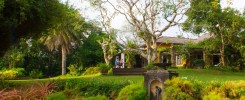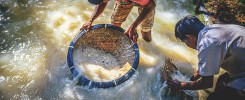Kande Viharaya – Aluthgama Kandavihara Yati Rd, Beruwala, Sri Lanka
Nestled amidst the serene hills, Kande Viharaya, established in 1734, stands as one of Sri Lanka’s paramount Buddhist temples. This sacred sanctuary embodies the essence of tranquility and the profound teachings of Buddhism. The temple’s relic chamber, adorned with Kandyan Era frescoes, is a cherished gem within its premises. Having undergone renovations under state patronage, Kande Viharaya is now recognized as an archaeological site, captivating every visitor with the unfolding pages of a fascinating narrative. 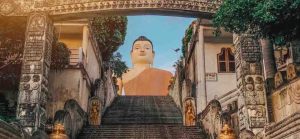
Exploring the Rich History and Significance of Kande Viharaya
Kande Viharaya traces its roots back to approximately 1734 when Venerable Karapagala Dewamitta Thero, guided by Venerable Udugama Chandrasara Thero, the Chief incumbent of Raja Maha Vihara Galapatha, founded the temple. Over the centuries, the temple has flourished under the stewardship of seven Maha Theros, including Venerable Pothuwila Sri Saranatissa Thero. Today, it is led by Venerable Batuwanhene Buddharakkhita Thero, the chief Sangha Nayake of Kalutara District and Bentara Walallawita Korale.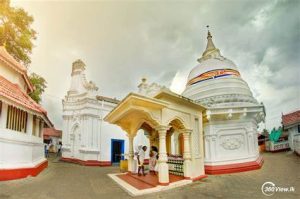
The Sacred Elements of Kande Viharaya
1. The Stupa: At the heart of the temple grounds, a bell-shaped stupa, enclosed within an octagonal shelter, is a symbol of deep reverence. Its meticulous craftsmanship showcases intricate flower petal mouldings, basal terraces, a majestic dome, and square enclosures adorned with Bo leaf engravings. The stupa’s construction dates back to the 2479th Buddhist era, initiated by Ven Pothuwila Sri Saranatissa Nayaka Thero.
2. The Relic Chamber: This ancient chamber, adorned with a stone door frame and a moonstone at the entrance, holds immense historical importance. It houses the sacred relic casket and is adorned with paintings from the later Kandyan period, adding to its allure.
3. The Bo Tree: Standing for over 300 years and surrounded by a square-shaped wall, the Bo tree is a focal point for pilgrims. Sculptures within the wall depict the events related to the arrival of the Branch of Sri Maha Bodhi to Sri Lanka, creating a captivating sight for visitors.
4. The Image House: An architectural marvel characterized by intricate floral and creeper designs, the image house was erected in 1731. It features three arched entrances and a mesmerizing Thorana. Inside, one can find Buddha images in various postures, including standing, seated, and reclining. The outer chamber of the image house features mural paintings and Deva Mandira dedicated to God Vishnu.
5. Devale and Deities: Sri Vishnu Maha Devala, situated adjacent to the outer chamber of the image house, is a place of worship for Sri Lankan and foreign devotees. It is customary for devotees to pay homage to the Buddha before seeking blessings from God Vishnu. The devala’s paintings depict events related to Vijaya’s arrival in Sri Lanka. Near the image house, Kataragama Devala and the four Maha Devalas enhance the temple’s religious significance, offering spiritual fulfillment and blessings.
6. Seema Malaka and Vinaya Kamma: This area outside the vihara serves as a venue for Vinaya Kamma rituals. Devotees engage in religious practices and observe traditions in this serene environment adjacent to the vihara and the Bo Tree, surrounded by lotus-petalled ponds.
7. The Five-Storied Building and Facilities: A five-storied building on the temple grounds houses various facilities. The topmost floor holds another relic chamber preserving sacred relics. The floor below features a museum displaying antiquities, ancient books, and valuable items for public viewing. Additionally, the Sri Saranatissa Memorial Library, established by Venerable Batuwanhene Buddharakkitha Nayaka Thero and Yatadolawatte Ariyawansa Thero, fosters academic research and knowledge.
8. Saranatyissa Dhamma Hall and Kshetharama Maha Pirivena: The Saranatyissa Dhamma Hall, located near the Bo Tree, hosts classes conducted by the Kshetharama Maha Pirivena. Founded in 1904 and led by Venerable Yatadolawatte Ariyawansa Thero, this educational institution significantly contributes to the nation’s educational landscape.
9. The Project for the Highest Buddha Statue: An ambitious project at Kande Viharaya aims to construct the tallest Buddha statue in Sri Lanka. The foundation stone for this statue, depicting the Bhoomisparsha Mudra, was laid in November 2002. Spearheaded by Venerable Batuwanhene Sri Buddharakkitha Nayaka Thero and Venerable Yatadolawatte Ariyawansa Thero, this endeavor aims to inspire reverence. The Buddha statue, standing at an impressive 107 riyals (160 feet) in height, will be adorned with religious paintings and sculptured events.
Travel Directions to Kande Viharaya – Aluthgama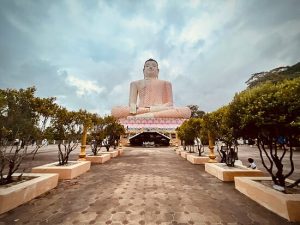
To reach Kande Viharaya from Colombo, take the Panadura-Kalutara route. After passing Beruwala, look for the “Kaluwamodara” bridge, approximately 59 km (36 miles) from Colombo. Turn left after crossing the bridge and continue for about 1 km toward “Kaalawila” until you arrive at Kande Viharaya. The journey from Colombo to Kande Viharaya takes approximately 1 hour and 15 minutes.
Kande Viharaya in Aluthgama is a remarkable Buddhist temple steeped in historical and religious significance. With its ancient stupas, relic chamber, image house, devales, and other sacred structures, the temple offers visitors a serene and spiritually uplifting experience. The ongoing project to construct the tallest Buddha statue in Sri Lanka further enhances the allure of Kande Viharaya. Plan a visit to this divine destination and immerse yourself in the rich cultural heritage and spiritual ambiance it offers.
FAQs
FAQ 1: Is Kande Viharaya accessible to visitors? Answer: Yes, Kande Viharaya warmly welcomes visitors of all backgrounds and provides accessible facilities for a comfortable experience.
FAQ 2: Are there any entrance fees to visit Kande Viharaya? Answer: No, there are no entrance fees to enter Kande Viharaya. However, donations are appreciated to support the maintenance and development of the temple.
FAQ 3: Can I take photographs inside Kande Viharaya? Answer: Yes, photography is allowed within the temple premises. However, it is advisable to be respectful and adhere to any guidelines provided by the temple authorities.
FAQ 4: Are there accommodation options near Kande Viharaya? Answer: Certainly, several accommodation options are available in the nearby towns of Aluthgama and Bentota, catering to various budgets and preferences.
FAQ 5: Are there any dress code restrictions when visiting Kande Viharaya? Answer: While there are no strict dress code requirements, it is advisable to dress modestly and respectfully when visiting any religious site in Sri Lanka.

